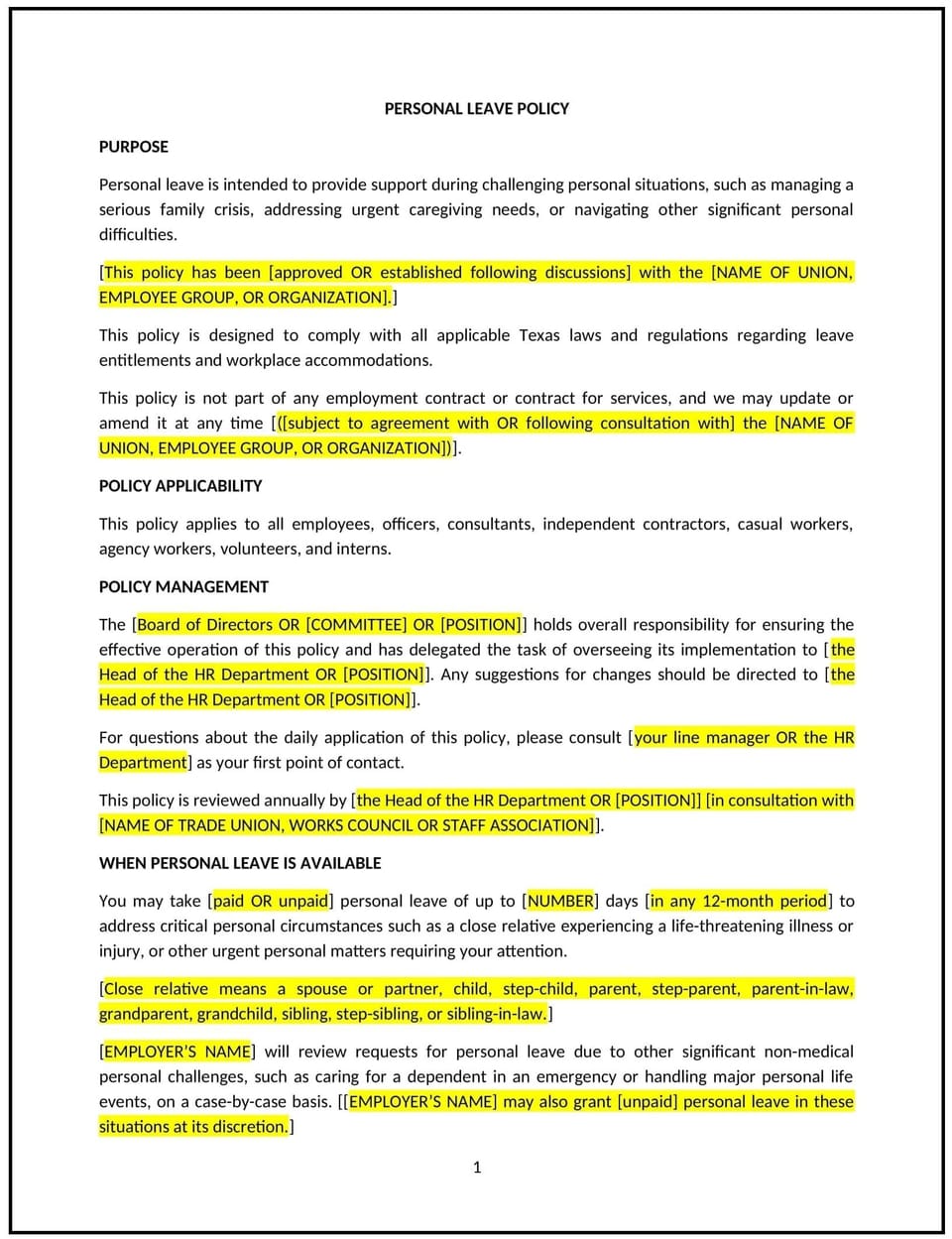Personal leave policy (Texas): Free template

Personal leave policy (Texas)
This personal leave policy is designed to help Texas businesses establish clear guidelines for providing employees with personal leave for personal, family, or other urgent matters that require time away from work. The policy outlines the process for requesting personal leave, the eligibility criteria, and how leave requests will be managed to ensure fairness and consistency.
By adopting this policy, businesses can promote a healthy work-life balance, support employee well-being, and maintain efficient business operations while accommodating employees' personal needs.
How to use this personal leave policy (Texas)
- Define eligibility: Specify which employees are eligible for personal leave, such as full-time, part-time, or temporary employees. The policy should outline the criteria for eligibility, including length of service or any other factors that may apply.
- Set leave duration: Define the maximum duration for personal leave and whether it is paid or unpaid. If the company offers paid personal leave, specify the amount of leave provided and whether it will be deducted from PTO or vacation time.
- Address leave requests: Outline the process for requesting personal leave, including the notice period employees must provide before taking leave and any documentation that may be required, such as medical certificates or urgent care notices.
- Define leave approval process: Specify who is responsible for approving or denying personal leave requests, and how employees will be notified about the status of their leave requests. The policy should ensure that the process is transparent and equitable.
- Address unforeseen leave situations: Provide guidance for employees who need to take leave unexpectedly, such as due to a family emergency or illness. Specify whether there is flexibility in the approval process for last-minute leave requests.
- Discuss impact on benefits: Clarify whether personal leave will affect employee benefits, such as health insurance or retirement contributions, and whether benefits will continue during the leave period.
- Set expectations for return to work: Specify the expectations for employees returning from personal leave, including how much notice they need to give when returning and any documentation required.
Benefits of using this personal leave policy (Texas)
This policy offers several benefits for Texas businesses:
- Promotes work-life balance: By offering personal leave, businesses support employees’ ability to manage personal matters without the need to miss work without authorization, reducing stress and promoting overall well-being.
- Enhances employee retention: Providing personal leave demonstrates that the business values employees' personal needs, which can improve job satisfaction and reduce turnover.
- Supports productivity: By accommodating personal leave, businesses help employees remain focused and engaged when they are at work, knowing that they have access to leave when personal matters arise.
- Increases fairness and transparency: By setting clear guidelines and a consistent process for managing personal leave, businesses ensure that all employees are treated fairly and equally.
- Improves employee morale: Allowing employees to take personal leave when needed without penalty can improve morale and contribute to a positive work culture.
Tips for using this personal leave policy (Texas)
- Communicate the policy clearly: Ensure that all employees are aware of the personal leave policy and understand how to request leave, eligibility requirements, and the duration of leave available.
- Be flexible with urgent leave: Allow flexibility in the process for urgent leave requests, especially in situations like family emergencies or sudden illness, while maintaining consistency in how requests are handled.
- Keep records: Maintain accurate records of personal leave taken by employees, including documentation and approval details, to ensure transparency and to avoid disputes.
- Review regularly: Periodically review the policy to ensure it remains effective and in line with company practices, industry standards, and any updates to Texas state laws.
Q: Who is eligible for personal leave?
A: The policy should specify which employees are eligible for personal leave, such as full-time, part-time, or temporary employees, and may outline specific criteria like length of service or job role.
Q: How much personal leave is an employee entitled to?
A: The policy should specify the maximum amount of personal leave an employee can take, whether it is paid or unpaid, and any limitations on how often leave can be requested.
Q: How should employees request personal leave?
A: Employees should notify their supervisor or HR department in advance when possible, providing details about the reason for the leave and any supporting documentation. The policy should specify the notice period required and the documentation needed.
Q: Can personal leave be used for emergencies?
A: Yes, personal leave can be used for urgent matters such as family emergencies or personal health issues. The policy should outline the process for requesting emergency leave and any flexibility in approval.
Q: Does personal leave affect my benefits?
A: The policy should clarify whether personal leave affects employee benefits, such as health insurance or retirement contributions, and whether benefits continue during the leave period.
Q: How often should this policy be reviewed?
A: The policy should be reviewed annually or whenever there are significant changes in Texas state laws, federal regulations, or company practices related to personal leave.
This article contains general legal information and does not contain legal advice. Cobrief is not a law firm or a substitute for an attorney or law firm. The law is complex and changes often. For legal advice, please ask a lawyer.


